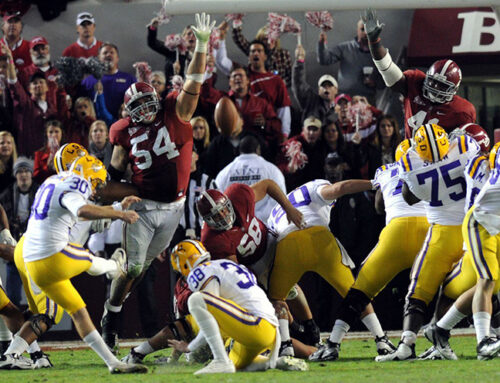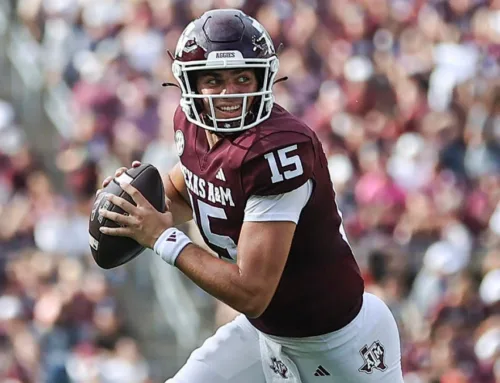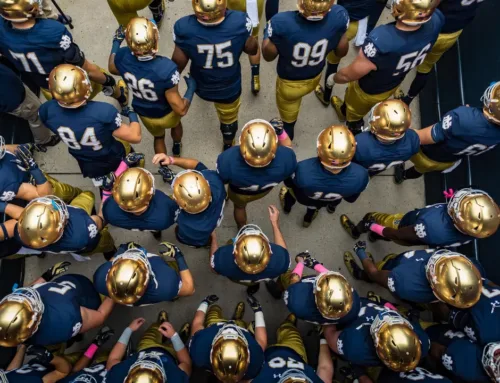We are approaching a decade since the major conference realignment recast college football and helped to usher in the playoff era of today. The topic of further expansion or contraction of conference ebbs and flows over the years but has mostly remained a dormant discussion outside of a rare treatise on the future of Texas football or the changes coming soon in the Player Movement era.
Recently, across the Atlantic Ocean a bombshell report from Sky Sports wrote that a new European Premier League in soccer could be formed and begin play in just a few years from now. To spare you the details, basically the top club soccer teams from the Big 5 countries (England, France, Spain, Italy, Germany) would form a 16 or 18-team super league to increase their share of wealth and power over the sport. It likely won’t happen anytime soon–as it’s largely a leverage move within their own countries–but it’s a fun (or maybe depressing!) scenario to think about.
What if the biggest programs in college football attempted something similar in the future here in America? Could it be done?
BREAKING: Liverpool and Manchester United among top clubs in talks over bombshell plot to join new FIFA-backed ‘European Premier League’
— Sky Sports News (@SkySportsNews) October 20, 2020
On the surface, it would seem near impossible for college football. The soccer clubs in Europe would plan on creating a new league–but the crucial difference being–they would still compete in their own domestic leagues, too. The large increase in games for soccer is a stumbling block for the sport but theoretically it’s possible for them to work out some compromise or decrease the size of a new league.
It’s difficult to believe you could ever convince Alabama to not compete in the SEC or for Ohio State not to compete in the Big Ten. In college football, you couldn’t play in 2 league simultaneously. Setting aside the mountain of contracts to negotiate from out under, this is probably a no-go for programs who truly feel their regional hegemony is paramount.
Be that as it may, let’s pretend it could happen. Who should make it in the College Football Premier League? Using a combination of historical prestige and modern program value we have several no-brainers:
*Ohio State
*Michigan
*Alabama
*Georgia
*LSU
*Florida
*Oklahoma
*Texas
*USC
*Notre Dame
*Florida State
*Clemson
This is 12 teams and I don’t think anyone could argue excluding anyone* from that group. Ten years ago it would be nearly unthinkable to include Clemson but averaging about 13 wins a year with 2 National Championships since has its perks.
*Okay, maybe this group is a little more controversial than I thought and needs further some skepticism. It includes 18 out of the last 19 National Champions and 20 out of the last 22 champs. Only Georgia, Notre Dame, and Michigan haven’t won a title in that time frame. UM has 2 major bowl wins since 1999, Georgia has 4 major bowl wins, and while Notre Dame has zero such trophies we’ve been far more consistently better than Michigan (who would likely be the one team above not to make it but honestly Ohio State would insist on it just so they can keep beating them).
Here are the other teams to consider:
2020 Program Value per Forbes
1 Texas A&M
2 Auburn
3 Tennessee
4 Penn State
5 Oregon
6 Washington
7 Nebraska
8 Wisconsin
9 Miami
All-Time Winning Percentage
1 Nebraska
2 Penn State
3 Tennessee
4 Miami
5 Auburn
6 Washington
7 Texas A&M
8 Wisconsin
9 Oregon
Winning Percentage Since 2000
1 Oregon
2 Wisconsin
3 Auburn
4 Miami
5 Penn State
6 Nebraska
7 Texas A&M
8 Tennessee
9 Washington
Before I go any further, I have to decide how large I want this new league to be. Let’s proceed with a 16-team league because it’s the most fun. That means, we can only pick 4 teams from the above list.
We’ll cross off the following effective immediately: Tennessee, Nebraska, and Washington.
Obviously, a tough call for programs who have a rich history and won at least one National Title in the 1990’s which isn’t that long ago. Still, the Vols and Cornhuskers haven’t been nearly good enough in recent times to be included. Tennessee hasn’t won their division since 2007 and hasn’t finished in the top 10 since 2001. Nebraska hasn’t won 11 games since 2001 and hasn’t won a conference title since 1999.
Washington is a little tougher to cross off for a couple reasons. One, we’d like more presence from the west coast. Two, they were so, so bad for most of this century but have been one of the best teams in the Pac-12 for the past 7 years and won conference titles twice in recent years. They’d feel hard done by and I understand.
The last 4 spots I am giving to: Auburn, Oregon, Penn State and Miami. The 16-team College Football Premier League would now include all of the champions over the last 22 years.
Unfortunately, Texas A&M is the big money-maker who loses out but I don’t think we need another SEC/Southern team to the mix. I’m sure Wisconsin would feel appalled by this decision due to their recent success over the past couple decades. But, they are like Texas A&M in that we don’t need another team from the Big Ten, plus they don’t make nearly enough money.
***
Set in Stone?
Following the formation of the College Football Premier League the old conferences will have to be modified.
ACC – Boston College, Duke, Georgia Tech, Louisville, North Carolina, NC State, Pitt, Syracuse, Virginia Tech, Virginia, and Wake Forest PLUS new 12th member Appalachian State
Big Ten – Illinois, Indiana, Iowa, Maryland, Michigan State, Minnesota, Nebraska, Northwestern, Purdue, Rutgers, and Wisconsin PLUS new 12th member Cincinnati.
Big 12 – Baylor, Iowa State, Kansas, Kansas State, Oklahoma State, TCU, Texas Tech and West Virginia PLUS new members (4): Houston, SMU, Louisiana, and Marshall.
Pac-12 – Arizona, Arizona State, California, Colorado, Oregon State, Stanford, UCLA, Utah, Washington, and Washington State PLUS new members (2): Boise State and BYU.
SEC – Arkansas, Kentucky, Mississippi State, Missouri, Ole Miss, South Carolina, Tennessee, Texas A&M, and Vanderbilt PLUS new members (3): UCF, USF, and Memphis.
3 Questions
1) Would Notre Dame actually join the College Football Premier League?
Let’s start here. If news broke tomorrow that somehow an alliance of Ohio State/Michigan/Alabama/Auburn/Texas/Oklahoma were interested in forming a new super league and were ready to invite 10 more teams, would Notre Dame join without hesitation?
I’m thinking yes, and it wouldn’t be a terribly difficult decision from Notre Dame leaders. It would mean effectively ending over a 100 years of independence, losing the NBC television contract, and killing rivalries like Navy but it would be a trigger to pull in order to compete at the highest level and not be shut out of that exclusive club.
2) Does a new conference form between FBS and FCS?
It would probably make sense for the remaining Power 5 conferences to separate themselves from the current Group of 5 conferences in this new system. Some of those conferences would be really weakened in this new set up. The AAC would be without Cincinnati, Houston, SMU, UCF, USF, and Memphis which leaves the best teams like Navy and Tulsa.
Conference USA would lose Marshall, the Mountain West would lose Boise State, while the Sun Belt would lose Louisiana and App State. Only the MAC would be left untouched.
It would make sense for 11 new teams to move up the FBS Group of 5 level. Maybe these ones: Delaware, Eastern Washington, Idaho, Illinois State, Jacksonville State, James Madison, Montana, North Dakota State, Richmond, Sam Houston State, and Youngstown State.
3) Relegation: Yes or no?
A new European premier league in soccer will ultimately deal with this should it come to pass: Do they welcome new teams into their pact? In the relegation crazy nature of European soccer it’s far easier (the clubs have proposed a relegation of some sort every 10 years, as one possibility, which is crazy in its own right) to pull off and would throw a bone to some seriously legendary clubs who would be shut out initially.
As fantastical of an idea as this is for college football, it’s difficult to imagine a relegation model being implemented even though competitively speaking it probably should. Some day if a super league is formed it’ll be too bad for the teams that don’t get invited but it would be cool to see the likes of A&M, Wisconsin, and others with the ability to make it in each year if they qualified.
The biggest obstacle is the conferences themselves. You could have the champion of the Power 5 playoff promoted to the Premier League but when Michigan finishes in last place do they go back to the Big Ten? And what if Michigan sucks so bad they get relegated to the Group of 5? Which conference do they play in then? Same issues apply for teams getting promoted–they’d be leaving a conference and not necessarily being replaced by a team that was in their conference. Plus, how do you figure out who the relegated teams are in a system with 5 huge conferences?
You’d almost have to break up the Power 5 and Group of 5 into half a dozen smaller leagues to make it work. Or, just don’t do relegation and the Premier League of College Football is set in stone forever.





I think you left Oregon off the list, but they’re not in your new PAC12, so I assume they’re in the Premier League?
I did something like this with my NCAA14, I was in a dynasty and remade a conference to be made out of the top 12 teams from the previous year as my Champions League Conference. A little different since that still works within the confines of the current season, and this idea is split out a bit different.
It turned out to be lovely chaos with the best teams all holding the others down, I think like 7-3 would usually be the best Champions league conference record, so the leftovers from the other P5 groups tended to make and win the national championships by virtue of it being a lot easier for them to lose less games, especially not playing the best teams.
Also —
“And what if Michigan sucks so bad they get relegated to the Group of 5? Which conference do they play in then?”
Lovely thought and I assume they would get lumped in with their directional mates and get some MAC-tion going on.
Whooops, I forgot to include Oregon.
Penn State is not out, added them back in on a second edit.
Only one team further west than I-35? This is massively unbalanced. How would you handle the relegation alignment with the NCAA? If you’re pulling up and sending teams back down there, you’d have to include them in the discussion. I’m thinking you’d never get their support if you tried to pull something like this off.
The NCAA? Ha, not worried in the least bit.
College football is massively unbalanced geographically, no?
USC, Oregon & Texas are all west of 35, no? And Norman is on 35
He added Ore after I made this comment. Texas is ON 35, as is OU. That was why I thought it seemed odd.
EM, Well that’s kind of my point here. You take this “to hell with the NCAA” mentality, but to make this work I think you have to include them. Take the scUM example that was brought up. If they continue their suckitude and get to a level where you just can’t keep them in the premier league anymore and you want to relegate them, you have to bring up a team from somewhere. That’s going to have to be the NCAA or whatever becomes of them and serves as the home for your second tier teams. How and why would that NCAA allow you to bring a team up from there and why and how would they allow you to send a team down to them? You’d have to have SOME kind of partnership and I don’t see how they would do that if your ultimate goal is to screw them over.
In this hypothetical of mine, the NCAA doesn’t exist anymore. We don’t need them.*
*Were they ever needed?
Well someone has to be the governing body that awards a title. The NCAA name is just what it is. If you create a new entity, call it what you will but it serves the same purpose.
The NCAA has only awarded a title for like 20 years. Newspapers awarded titles for the first 100 years of CFB
The NCAA has never awarded an FBS football championship. I’m assuming clearwall is referring to what the effect of this Premier League concept would be on other sports.
I didn’t even realize BCS and CFP weren’t associated with NCAA.
It would serve the same purpose, but work only for football playing schools, keep the NCAA around for basketball, crew, volleyball, fencing & the like. If all football playing universities buy in, then there’s no issue. The goal/reward of a Middle Tennessee State or Montana is the same, to move up and make it to the top. It’d be a tougher sell for the Illinois/Kansas/Vanderbilt ilk who would be prime for immediate relegation, but, get your shit together and don’t be terrible all the time.
Looking at this map, I-65 might be a better 50/50 split for “Premier” teams
I read three times but I’m not seeing it — Who’s the 4th? “Auburn, Oregon, and Miami” and…
I might be dumb.
I believe the 4th is, and Eric can correct me if I’m wrong, collect underpants.
I originally had PSU, then forgot about Oregon, then forgot I needed 4 more teams.
PSU and Oregon are both in the CFPL.
My idea is based on the theory that in Eric’s proposal, the Premier League would feature a 15-game schedule where everyone plays everyone, top 4 move on to a playoff, bottom 4 are in the relegation zone. –OR– 2 divisions, 8 teams per division – the divisions are all on an East/West or North/South split. Each team plays all 7 teams in their division and 5 randomly drawn teams from the other division (Or 4 if that makes more sense with the actual scheduling). Worst two from each division are in the relegation zone.
For the rest of the FBS, the following:
All “conferences” are made up of 2 divisions, 8 teams per division – the divisions are all on an East/West or North/South split, mirroring the split from above, if necessary. Each team plays all 7 teams in their division and 5 randomly drawn teams from the other division (Or 4 if that makes more sense with the actual scheduling).
Simple as pie.
I love it, let’s do it.
Very interesting discussion, but for me I’m not really into the idea of a 16 team power league. I think that, after a few years, it would get old to play the same teams every year and it would lose some of the fun of college football where a team like ND can try to schedule a new opponent each year (or one that hasn’t been played in decades). Another negative to me (as noted in one of the comments above) is that there would be a lot more losing (because of the high level of competition each week).
I could actually see this happening. Not based on who deserves it, but the teams who make enough money to pay their players and are tired of dealing with the joke of the NCAA (so the who deserves it in the capitalist sense). Of course that would require those schools to give up unpaid labor, so maybe I can’t see this happening.